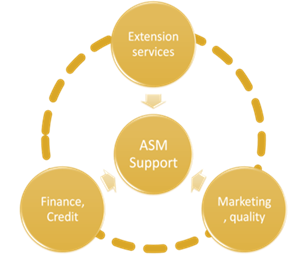
Liberia ASM Profile Political Economy & Strategic Standpoints | Social and Environmental Factors | Local linkages | ASM Sites in Liberia
The Liberian mining industry suffered significantly from the 2003 civil war. The issues around conflict minerals led the implementation of diamond sanction, which were lifted in 2007. The mineral sector in the country also faced many more challenges from falling commodity prices especially of its main export iron ore, but also from the Ebola outbreak. Despite the many challenges faced by the sector it is a substantial GDP contributor, during the 2013/2014 fiscal year extractive industries contributed to 58% of the Liberian GDP.
Gold mining in Liberia reportedly began at the turn of the 19th Century with the first significant rush taking place in 1943 in Grand Cape Mount County. Liberia’s commercial gold reserves are located in Ndablama and Weaju. The New Liberty Gold Mine, which is Liberia’s First and largest commercial gold mine started commercial production in 2016. It is estimated that about 100.000 people are engaged in the artisanal mining sector of Liberia (INMF, 2008), mainly extracting gold and diamonds. Despite the sector’s mostly informal nature, the Central Bank of Liberia reports that in 2015, official export figures indicated that 30.2 million USD worth of diamonds were exported from Liberia, making up about 18% of all official mineral exports (iron ore, gold, and diamonds).
Liberia has a long history of alluvial diamond production in the western and central parts of the country with outputs estimated at about 14 million carats during the last 50 years.
Previous studies commissioned by USAID put the estimates of miners without license at approximately 95%. Liberia is actively promoting the industrialization of diamond and gold mining making ASM a low priority in its mining code and policies.
Country Mining Vision Status
CMV Processes Underway.
Policies, Laws and Regulations Currently in Effect
Liberia Minerals and Mining Law of 2000
Minerals and Mining act 2006
ASM Associations or Cooperatives
I. FOMAL: Federation of Miners Association of Liberia
II. LMAL: Local Miners Association of Liberia
ASM Definition Criterion
Area size; nationality; mechanization
ASM Licensing
Artisanal: YES
Small Scale Mining: YES
ASM Minerals or Metals Exploited
Precious Metals Gold
Base Metals Iron ore
Precious Stones Cement, Sand, phosphate
Development Minerals Diamond Cobalt, lead, manganese, nickel, granite, ilmenite, sulfur
ASM SUPPORT TRIANGLE

Mining Code Provisions for Women in ASM
No provisions or mentions of Women in the Mining code
Mineral Policy of Liberia:
Issue: Promotion the creation of a stable and conducive business climate
Policy Objective: Provide a framework for the sustainable management of the country’s mineral resources and to guide interventions by government institutions as well as other stakeholders.
Policy Statement:
The main strategies of the government are to revive the mineral sector to enhance its contribution to government revenues by:
I. Formulating a fiscal and concessioning regime that assures the country of fair value for its resources, while offering equitable rewards to private investors;
II. Putting in place a mechanism for the evaluation of competing land use options;
III. Supporting and enabling artisanal and small scale mining activities to create employment, generate income and help reduce poverty in the rural areas; and
IV. Facilitating equitable access to the sector by all qualified Liberians, irrespective of gender or ethnicity.
Mining Policy Environment:
Some of the most lucrative mines are located in remote and inaccessible areas in forest regions, and the government lacks the necessary resources or capacity to monitor mining activities. The ministry’s objective is to encourage artisanal miners to organize their mining activities through cooperatives that would attract foreign investors into the sector.
Before the 2004 amendments, the 2000 Mining Code made no reference to “artisanal mining” the term was substituted by “small-scale mining”.
The Government is committed to attracting and enabling private sector investments for the development of mineral deposits, particularly iron ore mines, and to promote new investments in exploration and development of gold, diamonds, base metals and other mineral deposits. Since 2006, Liberia has made significant progress towards improving the governance framework around natural resource management with a policy based on the AMV. Liberia also established a Mineral Cadastral and enacted a Public Procurement and Concession (PPC) Act, which requires open, transparent and competitive bidding for known resource.
Finance and credit
Dealers are not allowed to engage directly with mining operations but they provide sponsorship to a minority of artisanal miners. However, the mineral policy of Liberia plans to make available extension services to support ASM operations through technical advice and the facilitation of capital (micro-loans) schemes.
Extension services - a phased approach to integration and capacity-building
The 2008 Mineral Policy of Liberia was supportive of ASM activities, stating that they should facilitate the training of ASM miners in business and technical skills and in mercury-free gold processing and should offer a micro-credit loan scheme.
Marketing and quality
The Monrovia-based diamond dealers are the only actors legally permitted to export diamonds, only Liberian citizens are allowed to work as brokers, and they channel the diamonds from miner to dealer, either as independently financed operators, or directly funded by a dealer.

